Reference no: EM132185363
Question 1 - For the common-source circuit in Figure P4.24, the bias voltages are changed to V+ = 3 V and V- = -3 V. The PMOS transistor parameters are: VTP = -0.5 V, Kp, = 0.8 mA/V2, and λ = 0. The load resistor is RL = 2 Ω ka (a) Design the circuit such that IDQ = 0.25 mA and VSDQ = 1.5 V. (b) Determine the small-signal voltage gain Av = vo/vi.
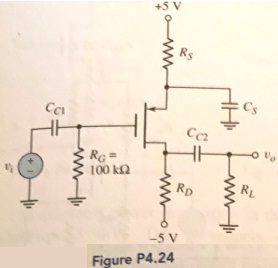
Question 2 - Design the common-source circuit in Figure P4.26 using an n-channel MOSFET with λ= 0. The quiescent values are to be IDQ = 6 mA, VGSQ = 2.8 V, and VDSQ = 10 V. The transconductance is gm = 2.2 mA/V. Let RL = 1 kΩ Av = -1, and Rin = 100 KΩ. Find R1, R2, RS, RD, Kn, and VTN.
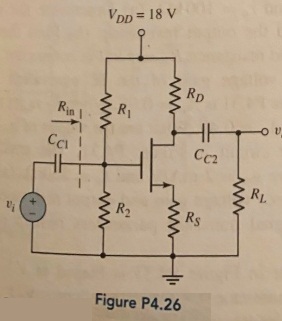
Question 3 - Consider the circuit in Figure P4.34. the transistor parameters are VTN = 0.6 V, kn' = 100μ A/V2, and λ = 0. The circuit is to be designed such that VDSQ = 1.25 V and such that the small-signal voltage gain is Av = 0.85. (a) Find IDQ. (b) Determine the width-to-length ratio of the transistor. (c) What is the required dc value of the input voltage?
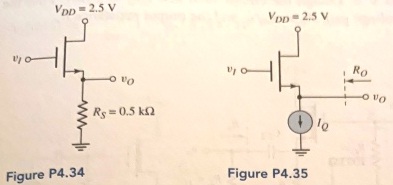
Question 4 - The quiescent power dissipation in the circuit in Figure P4.35 is to be limited to 2.5 mW. The parameters of the transistor are VTN = 0.6 V, kn' = 100 μA/V2, and λ = 0.02 V-1. (a) Determine IQ. (b) Determine W/L such that the output resistance is Ro = 0.5 kΩ. (c) Using the results of parts (a) and (b), determine the small-signal voltage gain. (d) Determine the output resistance if the transistor width-to-length ratio is W/L = 100.
Question 5 - The parameters of the circuit in Figure P4.36 are Rs = 4 kΩ, R1= 850 kΩ, R2 = 350 kΩ, and RL = 4 kΩ. The transistor parameters are VTP = -1.2 V, kp' = μA/V2 W/L = 80, and λ = 0.05 V-1. (a) Determine IDQ and VSDQ (b) Find the small-signal voltage gain Av = vo/vi. (c) Determine the small-signal circuit transconductance gain Ag = io/vi. (d) Find the small-signal output resistance Ro.

Question 6 - The small signal parameters of the NMOS transistor in the ac equivalent common-gate circuit shown in Figure p4.47 are VTN = 0.4 V, k'n = 100 μA/V2 W/L = 80 and λ = 0 The quiescent drain current is IDQ = 0.5 mA. Determine the small-signal voltage gain and the input resistance.

Question 7 - For the common-gate circuit in Figure P4.48, the NMOS transistor pares am: VTN =1 V, Kn = 3 mA/V2, and λ = 0. (a) Determine IDQ and VDSQ (b) Calculate gm and r0. (c) Find the small-signal voltage gain Av = vo/vi.
Question 8 - Consider the PMOS common-gate circuit in Figure P4.49. The transistor parameters are: VTP = -1 V, Kp = 0.5 mA/V2, and λ = 0. (a) Detemine RS and RD such that IDQ = 0.75 mA and VSDQ = 6 V. (b) Determine the input impedance Ri, and the output impedance Ro. (c) Determine the loaf current 4, and the output voltage vo, if = 5 sin ωt μA.
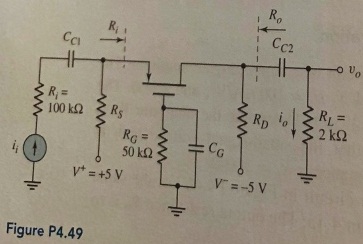
Question 9- The transistor parameters in the circuit in Figure P4.68 are the same as those given in Problem 4.68. The circuit parameters are VDD = 3.3 V, Rs1 = 1kΩ, and Rin = 250 kΩ. (a) Design the circuit such that tDQ1 = 0.1 mA, /n(: = 0.25 mA, Vpsei = 1.2 V. and ViDQ2 = 1.8 V. 0)) Determine the small-signal voltage gain Av = vo/vi
Question 10 - Consider the circuit shown in Figure P4.70. The transistor parameters are VTP1 = -0.4 V, VTN2 = 0.4 V. (W/L)1= 20, (W/L)2 = 80, k'p= 40 μA/V2 k'n = 100 μA/V2 and λ1 = λ2 = 0. Let = 200kΩ. (a) Design the circuit such that IDQ1= 0.1 mA, IDQ2 = 0.3 mA. VSDQ1 = 1.0 V and VDSQ2 = 2.0 V. The voltage across RS1 is to be 0.6 V. (b) Determine the small-signal voltage gain Av = vo/vi,. (c) Find the small-signal output resistance Ro.
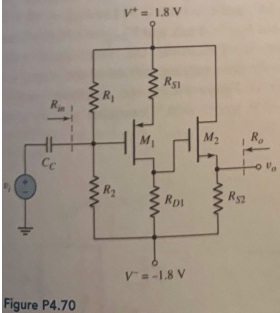
Question 11 - For the circuit in Figure P4.71, the transistor parameters are: Kn1 = kn2 = 4 mA/V2, VTN1 = VTN2= 2 V. and I = A2 O. (a) Determine IDQ1, IDQ2, VDSQ1, and VDSQ2, (b) determine gm1 and gm2, (c) Determine the overall small-signal voltage gain Av = vo/vi